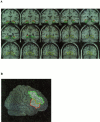Analysis of a distributed neural system involved in spatial information, novelty, and memory processing
- PMID: 11061338
- PMCID: PMC6871808
- DOI: 10.1002/1097-0193(200010)11:2<117::AID-HBM50>3.0.CO;2-M
Analysis of a distributed neural system involved in spatial information, novelty, and memory processing
Abstract
Perceiving a complex visual scene and encoding it into memory involves a hierarchical distributed network of brain regions, most notably the hippocampus (HIPP), parahippocampal gyrus (PHG), lingual gyrus (LNG), and inferior frontal gyrus (IFG). Lesion and imaging studies in humans have suggested that these regions are involved in spatial information processing as well as novelty and memory encoding; however, the relative contributions of these regions of interest (ROIs) are poorly understood. This study investigated regional dissociations in spatial information and novelty processing in the context of memory encoding using a 2 x 2 factorial design with factors Novelty (novel vs. repeated) and Stimulus (viewing scenes with rich vs. poor spatial information). Greater activation was observed in the right than left hemisphere; however, hemispheric effects did not differ across regions, novelty, or stimulus type. Significant novelty effects were observed in all four regions. A significant ROI x Stimulus interaction was observed - spatial information processing effects were largest effects in the LNG, significant in the PHG and HIPP and nonsignificant in the IFG. Novelty processing was stimulus dependent in the LNG and stimulus independent in the PHG, HIPP, and IFG. Analysis of the profile of Novelty x Stimulus interaction across ROIs provided evidence for a hierarchical independence in novelty processing characterized by increased dissociation from spatial information processing. Despite these differences in spatial information processing, memory performance for novel scenes with rich and poor spatial information was not significantly different. Memory performance was inversely correlated with right IFG activation, suggesting the involvement of this region in strategically flawed encoding effort. Stepwise regression analysis revealed that memory encoding accounted for only a small fraction of the variance (< 16%) in medial temporal lobe activation. The implications of these results for spatial information, novelty, and memory processing in each stage of the distributed network are discussed.
Figures





Similar articles
-
Novelty responses to relational and non-relational information in the hippocampus and the parahippocampal region: a comparison based on event-related fMRI.Hippocampus. 2005;15(6):763-74. doi: 10.1002/hipo.20098. Hippocampus. 2005. PMID: 15999342
-
Differential contributions of the parahippocampal place area and the anterior hippocampus to human memory for scenes.Hippocampus. 2002;12(6):718-23. doi: 10.1002/hipo.10077. Hippocampus. 2002. PMID: 12542224
-
A comparison of two FMRI protocols for eliciting hippocampal activation.Epilepsia. 2005 Jul;46(7):1061-70. doi: 10.1111/j.1528-1167.2005.62004.x. Epilepsia. 2005. PMID: 16026558
-
The human hippocampus and spatial and episodic memory.Neuron. 2002 Aug 15;35(4):625-41. doi: 10.1016/s0896-6273(02)00830-9. Neuron. 2002. PMID: 12194864 Review.
-
Novelty signals: a window into hippocampal information processing.Trends Cogn Sci. 2009 Feb;13(2):47-54. doi: 10.1016/j.tics.2008.11.004. Epub 2009 Jan 8. Trends Cogn Sci. 2009. PMID: 19135404 Review.
Cited by
-
The human amygdala plays a stimulus specific role in the detection of novelty.Neuroimage. 2011 Apr 15;55(4):1889-98. doi: 10.1016/j.neuroimage.2011.01.034. Epub 2011 Jan 20. Neuroimage. 2011. PMID: 21256226 Free PMC article.
-
Hippocampal activation and connectivity in the aging brain.Brain Imaging Behav. 2021 Apr;15(2):711-726. doi: 10.1007/s11682-020-00279-6. Brain Imaging Behav. 2021. PMID: 32314198 Free PMC article.
-
Imaging distributed and massed repetitions of natural scenes: spontaneous retrieval and maintenance.Hum Brain Mapp. 2015 Apr;36(4):1381-92. doi: 10.1002/hbm.22708. Epub 2014 Dec 12. Hum Brain Mapp. 2015. PMID: 25504854 Free PMC article.
-
Different activation dynamics in multiple neural systems during simulated driving.Hum Brain Mapp. 2002 Jul;16(3):158-67. doi: 10.1002/hbm.10032. Hum Brain Mapp. 2002. PMID: 12112769 Free PMC article.
-
Novelty detection and repetition suppression in a passive picture viewing task: a possible approach for the evaluation of neuropsychiatric disorders.Hum Brain Mapp. 2002 Dec;17(4):230-6. doi: 10.1002/hbm.10071. Hum Brain Mapp. 2002. PMID: 12395390 Free PMC article.
References
-
- Aguirre GK, Zarahn E, D'Esposito M (1998): An area within human ventral cortex sensitive to “building” stimuli: evidence and implications. Neuron 21: 373–83. - PubMed
-
- Amaral DG (1999): What is where in the medial temporal lobe? Hippocampus 9: 1–6. - PubMed
-
- Bohbot VD, Kalina M, Stepankova K, Spackova N, Petrides M, Nadel L (1998): Spatial memory deficits in patients with lesions to the right hippocampus and to the right parahippocampal cortex. Neuropsychologia 36: 1217–1238. - PubMed
-
- Brewer JB, Zhao Z, Desmond JE, Glover GH, Gabrieli JD (1998): Making memories: brain activity that predicts how well visual experience will be remembered. Science 281: 1185–1187. - PubMed
-
- Buckner RL, Kelley WM, Petersen SE (1999): Frontal cortex contributes to human memory formation. Nat Neurosci 2: 311–314. - PubMed
Publication types
MeSH terms
Grants and funding
LinkOut - more resources
Full Text Sources
Medical

